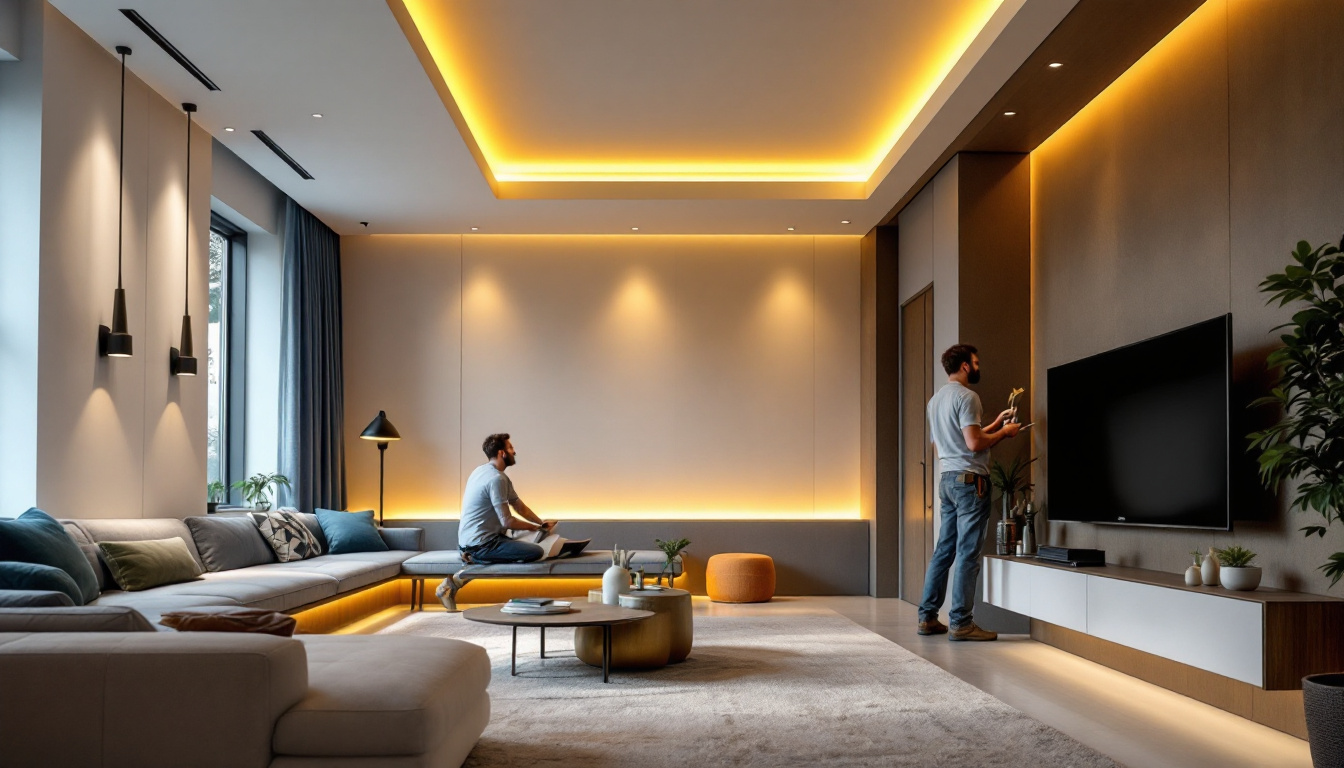
Lighting plays a crucial role in enhancing the aesthetics and functionality of a space. Among the various options available, Armacost LED tape lighting has gained popularity for its versatility and efficiency. However, even experienced lighting contractors can make mistakes when working with this innovative product. This article explores common pitfalls and offers insights into best practices for successful installations.
Armacost LED tape lighting is designed to provide flexible and energy-efficient illumination. It is available in various color temperatures and brightness levels, making it suitable for diverse applications, from residential to commercial spaces. The tape can be cut to size and easily installed in tight spaces, allowing for creative lighting solutions. Whether you are looking to enhance the ambiance of a cozy living room or illuminate a workspace with precision, Armacost LED tape lighting offers a versatile solution that can adapt to your specific needs.
Despite its advantages, improper installation or planning can lead to issues that compromise the effectiveness of the lighting. Understanding the product’s specifications and installation guidelines is essential for achieving optimal results. Furthermore, the longevity of the LED tape can be significantly affected by the installation environment; for instance, areas with high humidity or extreme temperatures may require additional considerations to ensure durability and performance.
Before beginning any installation, it is vital to familiarize oneself with the specifications of Armacost LED tape lighting. This includes understanding the wattage, voltage, and maximum run lengths. Many contractors overlook these details, which can lead to underperformance or even damage to the lighting system. Additionally, the choice of color temperature can dramatically influence the mood of a space; warmer tones can create a relaxing atmosphere, while cooler tones are often preferred for task-oriented areas.
For instance, exceeding the maximum run length can cause voltage drop, resulting in uneven brightness or flickering lights. Properly calculating the power requirements and ensuring adequate power supplies are essential steps that should not be neglected. It is also important to consider the tape’s adhesive backing, which should be applied to clean, dry surfaces for optimal adhesion. In environments where the tape may be exposed to moisture or heat, additional mounting methods may be necessary to ensure the longevity of the installation.
Accessories play a significant role in the overall performance of LED tape lighting. From connectors to power supplies, selecting the right components is crucial. Many contractors make the mistake of using generic accessories that may not be compatible with Armacost products, leading to installation failures. The use of high-quality connectors can also minimize potential points of failure in the system, ensuring a seamless and reliable lighting experience.
It is advisable to use manufacturer-recommended accessories to ensure compatibility and reliability. Additionally, understanding the differences between dimmable and non-dimmable options can prevent complications during installation and operation. Dimmable systems offer the flexibility to adjust brightness levels according to the time of day or activity, enhancing the functionality of the lighting. Moreover, integrating smart technology with Armacost LED tape lighting can open up a world of possibilities, allowing users to control their lighting through mobile apps or voice commands, making it an ideal choice for modern smart homes.
Even seasoned professionals can fall into the trap of making installation errors. These mistakes can lead to unsatisfactory results and may require costly rework. Identifying common pitfalls can help contractors avoid these issues and deliver high-quality installations.
One of the most frequent mistakes made during installation is inadequate surface preparation. For optimal adhesion, the surface where the LED tape will be applied should be clean, dry, and free of dust or grease. Failing to prepare the surface properly can result in the tape peeling off over time, leading to unsightly and inefficient lighting.
Contractors should take the time to clean the installation area thoroughly. Using isopropyl alcohol or a similar cleaning agent can help ensure a strong bond between the tape and the surface. Additionally, considering the temperature and humidity of the environment can also impact adhesion. For instance, applying LED tape in high humidity conditions can lead to moisture getting trapped underneath, which can compromise the adhesive quality. It’s also beneficial to check the surface for any irregularities, such as bumps or cracks, as these can interfere with the tape’s ability to adhere properly. A smooth, even surface is essential for achieving a professional finish.
Placement and alignment are critical factors in achieving the desired lighting effect. Many contractors underestimate the importance of planning the layout before installation. Poorly placed LED tape can create uneven lighting or fail to highlight key features of a space.
To avoid this mistake, contractors should take the time to visualize the final result. Utilizing design software or creating mock-ups can help in determining the best placement for the tape. Additionally, marking the installation path can ensure that the tape is applied in a straight line, enhancing the overall appearance. Furthermore, it’s important to consider the viewing angles and the intended use of the space. For example, in a kitchen, under-cabinet lighting should be positioned to minimize shadows while providing adequate illumination for food preparation. In contrast, ambient lighting in a living room may require a softer approach, with strategic placement to create a warm and inviting atmosphere. Taking these factors into account can significantly elevate the effectiveness of the lighting design.
Electrical considerations are paramount when working with LED tape lighting. Many contractors overlook critical aspects that can lead to safety hazards or system failures. Understanding the electrical requirements and adhering to local codes is essential for successful installations.
One common mistake is overloading electrical circuits. Each circuit has a maximum load capacity, and exceeding this limit can lead to tripped breakers or even electrical fires. Contractors should calculate the total wattage of the LED tape and ensure that it does not exceed the circuit’s capacity.
Additionally, using multiple power supplies may be necessary for larger installations. Properly distributing the load across multiple circuits can help prevent overload and ensure reliable performance.
Heat management is often an overlooked aspect of LED installations. While LEDs are more efficient than traditional lighting, they still produce some heat. If not managed properly, this heat can accumulate and shorten the lifespan of the tape lighting.
Contractors should consider using heat sinks or ensuring adequate ventilation in the installation area. Additionally, avoiding placement near heat sources can help maintain optimal operating temperatures and prolong the life of the lighting system.
Lighting is not just about functionality; it also plays a significant role in the overall design of a space. Many contractors make the mistake of focusing solely on technical aspects, neglecting the aesthetic impact of the lighting. A well-designed lighting scheme can elevate a space and create a welcoming atmosphere.
Color temperature is a crucial factor in setting the mood of a space. Armacost LED tape lighting is available in various color temperatures, from warm white to cool daylight. Contractors often overlook the importance of selecting the right color temperature for the intended application.
For example, warm white light is ideal for creating a cozy atmosphere in residential settings, while cool daylight is better suited for task-oriented spaces like kitchens or offices. Taking the time to understand the desired ambiance can significantly enhance the overall design.
Dimmer controls offer flexibility and can greatly enhance the functionality of LED tape lighting. However, many contractors neglect to incorporate dimming options into their designs. This oversight can limit the versatility of the lighting and reduce the ability to create different moods within a space.
Integrating dimmer controls allows users to adjust the brightness according to their needs, making the space more adaptable. It is essential to select compatible dimmers that work with LED technology to ensure smooth operation without flickering.
Even after a successful installation, issues can arise that may affect the performance of Armacost LED tape lighting. Addressing these concerns promptly can help maintain customer satisfaction and prevent future complications.
After installation, thorough testing is crucial to ensure everything is functioning correctly. Many contractors skip this step, assuming that the installation was successful based on visual checks alone. However, testing the system under various conditions can reveal potential issues that need to be addressed.
Contractors should check for consistent brightness, proper color rendering, and any flickering or dimming issues. Taking the time to conduct comprehensive testing can prevent callbacks and enhance the contractor’s reputation for quality work.
Educating customers about their new lighting system is an important aspect of the installation process. Many contractors fail to provide adequate information on how to operate and maintain the lighting, leading to confusion and dissatisfaction.
Contractors should take the time to explain the features of the Armacost LED tape lighting, including how to use dimmer controls and troubleshoot common issues. Providing written instructions or a quick reference guide can empower customers and enhance their overall experience.
Armacost LED tape lighting offers a versatile and energy-efficient solution for various lighting applications. However, lighting contractors must be aware of common mistakes that can hinder the effectiveness of their installations. By understanding product specifications, avoiding installation errors, addressing electrical considerations, and focusing on design, contractors can deliver high-quality results that meet customer expectations.
Ultimately, successful installations require a combination of technical knowledge, attention to detail, and a commitment to customer satisfaction. By avoiding common pitfalls and implementing best practices, lighting contractors can enhance their reputation and ensure the longevity of their projects.
Ready to avoid common installation mistakes with Armacost LED tape lighting? At LumenWholesale, we provide lighting contractors like you with the highest quality, spec-grade lighting products at exceptional wholesale prices. Say goodbye to local distributor markups and hello to a vast selection of reliable lighting solutions that meet rigorous industry standards. With free shipping on bulk orders, you can stock up on everything you need for your next project without any hidden fees. Elevate your lighting installations with the perfect combination of quality, affordability, and convenience. Wholesale Lighting at the Best Value is just a click away.

Discover the timeless allure of antique light bulbs and explore top strategies from lighting contractors to seamlessly integrate these vintage gems into modern spaces.

Discover why lighting contractors should prioritize recessed lighting in their projects.

Discover how harnessing light-powered technology can revolutionize the lighting industry, offering contractors innovative solutions to save time and reduce costs.

Discover the essential do’s and don’ts for lighting contractors when working with LED T5 lamps.